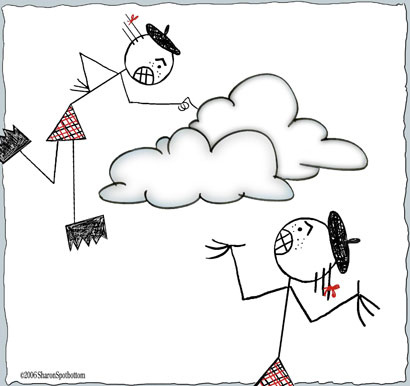Convergence
“It’s all one great big bloody mire.”

Nordurmýri, Reykjavík, 2004
Jar City, A Reykjavík Thriller, by Arnaldur Indriðason, Thomas Dunne Books, 2005
Promising Genomics, Iceland and deCODE Genetics in a World of Speculation, by Mike Fortun, University of California Press, 2008
Under the Glacier, by Halldór Laxness, Vintage International, 2005
These three books have converged on my consciousness this winter; I've referred to Jar City, (Original Icelandic title: Mýrin) several times before, but never given the book a proper review (as if I've ever given a "proper" review!) I had received it for Christmas (to replace a lost copy) from a blog-pal, and I recently got a glowing recommendation about it from another blog-pal. In the four years since my first reading of the book, I’ve read read four other Inspector Erlendur mysteries and was eager to revisit “the scene of the crime.” I’ve spent some time (not nearly enough!) prowling the streets of Reykjavík, including a stay in the Nordurmýri area (the foreground of the area pictured above) where the murder takes place. Arnaldur’s series seems authentic, indeed, the atmosphere of the settings and the psychology of Erlendur are more important than an actual crime. The plot-wrinkle in this book concerns genetic profiling, with references to a fictional “Genetics Research Centre.”
Promising Genomics is a non-fiction book about deCODE Genetics, a start-up company which raised millions on the promise of using the genetic data-base of the Icelandic population to decode inherited illnesses; the results could create new therapies and treatments. I was made aware of this book by yet another blog-pal and I was pleasantly surprised to find it an in-depth treatment of the actual institution which Arnaldur used so effectively in fiction. Mike Fortun does a good job explaining the irrational exuberance displayed by venture capitalists before, during and after the "internet bust" of 2002, when millions of dollars were raised and lost by deCODE on "promises" of scientific breakthroughs. The subject can be overwhelming at times, but Fortun cleverly models himself as a participant/observer, acknowledging and assuming the persona of “Embi”, a character from the Halldór Laxness novel Under the Glacier. The promoters of deCODE are portrayed as playing a con-game, but one in which there is just (barely) enough potential to keep it going. The book was published in 2008, so fallout from the failure of the Icelandic banking system was not covered.
Halldór Laxness’ great novel of ideas, Under the Glacier (Icelandic title: Kristnihald undir Jökli) seems (to me, at least) be getting better and better, the more I read it, and read of it. This book (published in 1968) is an examination of the modern dilemma, in all of its messy glory. Religion, technology, sex, morality and just plain everyday existence is hashed over in a uniquely Icelandic stew (Plokkfiskur?) Fortun’s book uses Glacier as a template, as well as references from Halldor’s other social satire The Atom Station. Glacier is a hard book to dive into—many of a Western reader’s cultural landmarks have gone missing or are deconstructed with a ‘ironic fatalism’, for the lack of a better word. There are implied promises in Glacier as well: the promise that Embi's report will have meaning and that Úa's anima can save Embi. Like deCODE, the promise is there, but never quite fulfilled.
There is always a place, a place beyond the “focus” where converging lines diverge again. I appear to be at that place now with the overlapping of three such diverse books. Still, I’ve found that Erlendur’s search for the meaning of a murder, Fortun’s search for meaning in a business model, as well as Embi’s search for the meaning of life itself, share similarities. When overlapped on my mental map of Icelandic culture patterns emerge, still beyond my understanding, but tantalizingly close.
Rose, Niranjana, and Mary: thanks again for the inspiration!
More on Halldor Laxness at Laxness in Translation




















